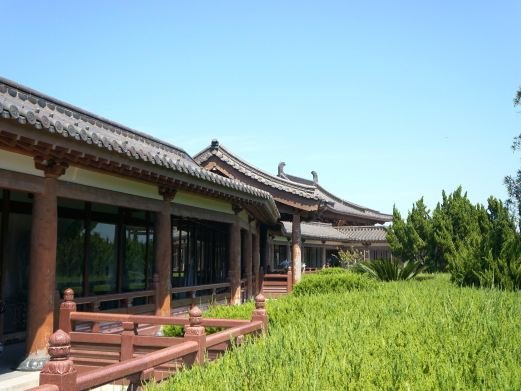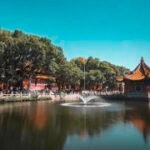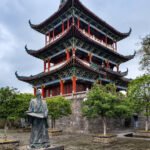Located within the Zi Jin Bamboo Forest, Guan Yin Temple of Reluctance is the earliest site for temple construction on Putuo Mountain. Coupled with the legend of ‘Guan Yin Who Refuses to Leave,’ it has become a well-known temple outside of the ‘Three Great Temples of Putuo.’ Pilgrims come to worship every day in a continuous stream, and because the temple is built by the sea, it is also an ideal location for photography enthusiasts. Walking from Zi Jin Bamboo Forest Zen Temple towards the sea, one will soon arrive at Guan Yin Temple of Reluctance. Although the temple is not large in area, it is recognized as the origin of Putuo Mountain’s ‘Buddhist Kingdom by the Sea.’ Almost every pilgrim or tourist who comes here can tell a few stories about ‘Guan Yin Who Refuses to Leave.’ The story goes that a Japanese monk named Hui E, who had invited a statue of Guan Yin from Wutai Mountain to return to his country, encountered sudden winds and waves when his boat passed through the Lianhua Ocean of Zhoushan Islands. The monk believed that the Bodhisattva was unwilling to go east, so he moored and left the statue ashore. Later, a farmer on the island vacated his house to enshrine the Guan Yin who was reluctant to leave. This led to the establishment of the first ‘Guan Yin Temple of Reluctance’ on the island, and subsequently, the numerous Buddhist temples on Putuo Mountain. The original structure of the temple no longer exists; the temple seen today was rebuilt in the 1980s. Perhaps because of this story, unlike the yellow-walled traditional Chinese Buddhist temples, Guan Yin Temple of Reluctance appears more like Japanese architecture. Although there are not many ancient relics in the temple, the legendary stories about this place are widely known, making it extremely popular with daily worshippers. In addition to the main hall’s Tang-style eleven-faced Guan Yin statue, there is also a ‘Thirty-Three Guan Yin Sacred Sites’ corridor on the west side of the temple, housing 33 Guan Yin statues for the devout to worship one by one. The Guan Hai Pavilion, directly opposite Guan Yin Temple of Reluctance, is an excellent spot for sea viewing, where one can rest when there are not many tourists. The nearby Chao Yin Cave, located in a secluded corner, is also suitable for enjoying the sea view and listening to the bustling tide. Many tourists also take photos in front of the ‘No Self-Immolation or Finger-Burning’ stele. The temple is open all year round from 06:00 to 17:30, with specific business hours subject to daily opening conditions.






